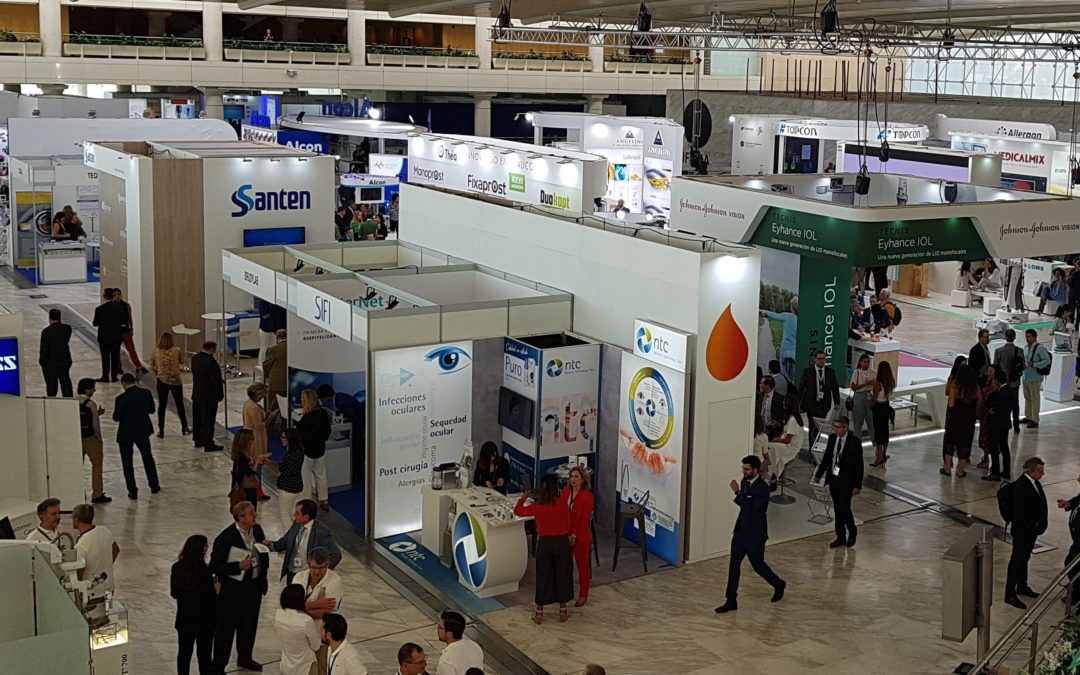From the 25th to the 28th of September, the last edition of our annual congress took place at the IFEMA congress hall in Madrid.
Almost 3,000 people have participated in this magnificent congress, and a total of 2,200 ophthalmologists registered. The best ophthalmologists in the country have been invited to share their knowledge and discuss the diagnostic and therapeutic developments in which they are currently a reference.
As usual in this type of event, there have been four intense days in which information is transmitted, collaborations between colleagues are scheduled, the different techniques are uploaded, valuing advantages and disadvantages and conclusions are drawn from all this, which benefit, as always to our patients.
Of this Congress it is also important to highlight the presentation of new drugs without preservatives for Glaucoma, which combine Prostaglandins and Beta blockers, such as Fixaprost from Thea laboratories.
Santen Laboratory has presented a new concept of artificial tear based on cationic technology in nanoemulsion.
Regarding the subspecialty of the retina, there has been a real advance in diagnostic imaging methods, such as angio-OCT and telemedicine. This fosters a relationship of understanding between doctor and patient in a very different way from the classical one.
New and better anti-VEG are already on the market for the treatment of age-related macular degeneration or AMD, such as Brolucizumab, which is being seen in studies, superior in effectiveness against Eylea and requires longer injections over time than with the current ones. Only one injection is needed every three months. Abicipar and Faricimab are two other Antiveg currently under study.
Dextenza or first intracanalicular slow-release corticosteroid has been developed to decrease inflammation and long-term pain.
Intescleral antiveg release reservoirs are also being studied as well, with a possible great projection in the future.
Xanternet, the first antibiotic associated with artificial tear for erosions or corneal ulcers with infectious risk, has been released.
The results of the different surgical devices for Glaucoma have been reviewed, evaluating cost effectiveness, being the Glaukos I-Stent inject of the best MIGS scored with the lowest risk of complications.
As for cataract and presbyopia surgery, the tendency of the different commercial houses to continue improving the multifocal intraocular lenses is being seen, with the combination of the concept of extended vision range, with the trifocality. This means an improvement in chromatic aberration and contrast sensitivity, as well as a better quality in distance vision. An example of this is with the new Tecnis Synergy lenses from Jonhson & Johnson laboratories, and the Finevision Triumf of “Physiol”.
In addition, as every year, there have been poster competitions and scientific communications, as well as videos that show interesting surgical techniques.
I would like to make a special mention for the presentation of this year. It was about the management of astigmatism, its diagnosis and treatment by a large number of experts all coordinated by Dr. Ruiz Mesa. The book of ethics in Ophthalmology, and the conference on the treatment of data and medical information based on artificial intelligence or Big Data were discussed. Something that will undoubtedly change the patterns of action and treatment in the not so distant future.


Recent Comments